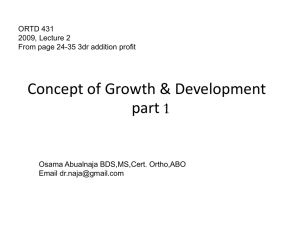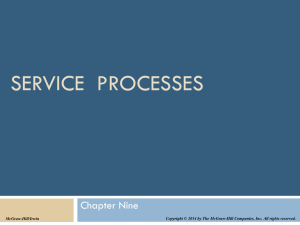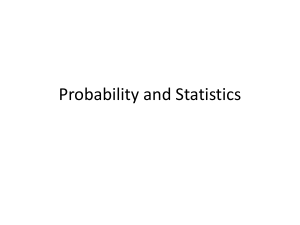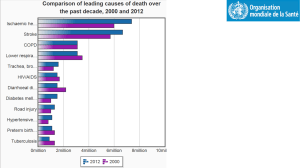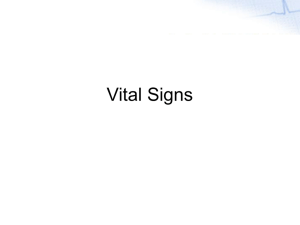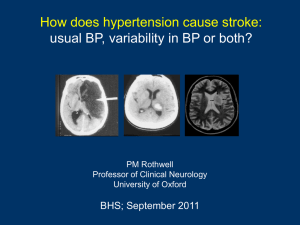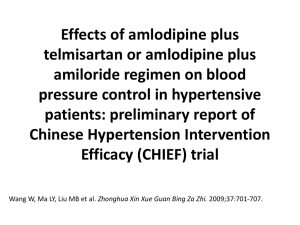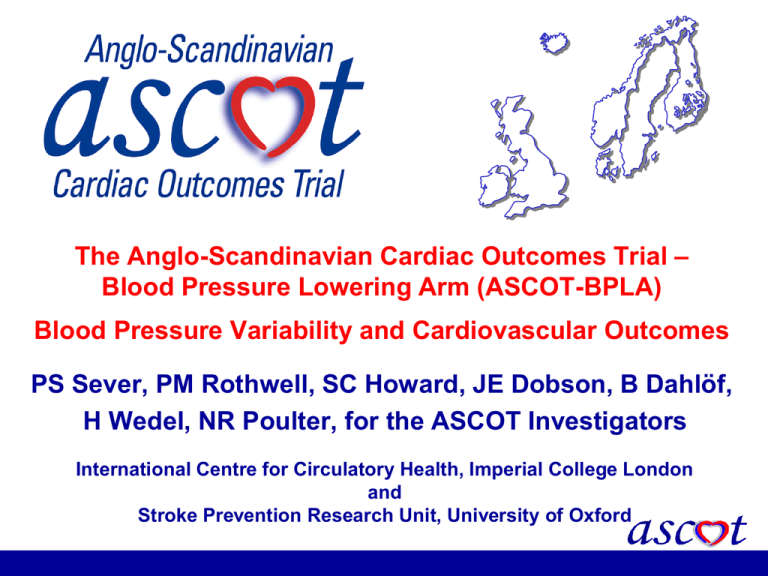
The Anglo-Scandinavian Cardiac Outcomes Trial –
Blood Pressure Lowering Arm (ASCOT-BPLA)
Blood Pressure Variability and Cardiovascular Outcomes
PS Sever, PM Rothwell, SC Howard, JE Dobson, B Dahlöf,
H Wedel, NR Poulter, for the ASCOT Investigators
International Centre for Circulatory Health, Imperial College London
and
Stroke Prevention Research Unit, University of Oxford
A randomised controlled trial of the prevention of
CHD and other vascular events by BP and
cholesterol lowering in a factorial study design
Study design
19,257
hypertensive
patients
atenolol ±
bendroflumethiazide
PROBE
design
ASCOT-BPLA
Stopped after 5.5 yrs
amlodipine ±
perindopril
Investigator-led, multinational randomised controlled trial
conducted in hypertensive patients, 40 -79 yrs, with no prior history
of CHD, but with 3 additional cardiovascular risk factors (male sex,
> 55 yrs, smoking etc )
Treatment algorithm to BP targets < 140/90 mmHg
or < 130/80 mmHg in patients with diabetes
amlodipine 5-10 mg
atenolol 50-100 mg
add
add
perindopril 4-8 mg
bendroflumethiazide-K
1.25-2.5 mg
add
doxazosin GITS 4-8 mg
add
additional drugs, eg, moxonidine/spironolactone
Median follow up was for 5.5 years
Baseline characteristics
Amlodipine ± perindopril
n = 9639
Atenolol ± thiazide
n = 9618
7381 (76.6%)
9187 (95.3%)
3168 (32.9%)
63.0 (8.5)
164.1 (18.1)
94.8 (10.4)
71.9 (12.7)
28.7 (4.6)
2567 (27%)
2169 (23%)
5.9 (1.1)
7361 (76.5%)
9170 (95.3%)
3110 (32.3%)
63.0 (8.5)
163.9 (18.0)
94.5 (10.4)
71.8 (12.6)
28.7 (4.5)
2578 (27%)
2162 (22%)
5.9 (1.1)
1841 (19.1%)
1825 (19.0%)
4280 (44.4%)
3518 (36.5%)
1046 (10.9%)
1851 (19.2%)
4283 (44.5%)
3510 (36.5%)
1004 (10.4%)
1837 (19.1%)
Demographic and clinical characteristics
Male
White
Current smoker
Age (years)
SBP (mmHg)
DBP (mmHg)
Heart rate (bpm)
BMI (kg/m2)
Diabetes
Other vascular disease
Total cholesterol (mmol/L)
Drug therapy
Previous antihypertensive treatments
0
1
≥2
Lipid-lowering therapy
Aspirin
Values are number of patients (%), or mean (SD)
Systolic and diastolic blood pressure
amlodipine perindopril
atenolol bendroflumethiazide
Blood pressure (mmHg)
180
160
164.1 SBP
163.9
Mean difference 2.7
137.7
140
136.1
120
100
94.8
DBP
Mean difference 1.9
94.5
79.2
80
77.4
60
Baseline
0.5
1
1.5
2
2.5
3
3.5
Follow-up (years)
4
4.5
5
5.5
Last
visit
ASCOT-BPLA: summary of all endpoints
Primary
Non-fatal MI (incl. silent) + fatal CHD
Unadjusted hazard
ratio (95% CI)
0.90 (0.79-1.02)
Secondary
Non-fatal MI (excl. silent) + fatal CHD
Total coronary endpoint
Total CV events and procedures
All-cause mortality
Cardiovascular mortality
Fatal and non-fatal stroke
Fatal and non-fatal heart failure
0.87 (0.76-1.00)
0.87 (0.79-0.96)
0.84 (0.78-0.90)
0.89 (0.81-0.99)
0.76 (0.65-0.90)
0.77 (0.66-0.89)
0.84 (0.66-1.05)
Tertiary
Silent MI
Unstable angina
Chronic stable angina
Peripheral arterial disease
Life-threatening arrhythmias
New-onset diabetes mellitus
New-onset renal impairment
1.27 (0.80-2.00)
0.68 (0.51-0.92)
0.98 (0.81-1.19)
0.65 (0.52-0.81)
1.07 (0.62-1.85)
0.70 (0.63-0.78)
0.85 (0.75-0.97)
Post hoc
Primary endpoint + coronary revasc procs
CV death + MI + stroke
0.86 (0.77-0.96)
0.84 (0.76-0.92)
0.50
0.70
1.00
Amlodipine perindopril better
1.45
2.00
Atenolol thiazide better
The area of the blue square is proportional to the amount of statistical information
Conclusions
• Amlodipine perindopril-based therapy
conferred an advantage over atenolol
thiazide-based therapy on all major CV
endpoints, all-cause mortality and new-onset
diabetes
• Additional statistical analyses demonstrated
that adjusting for blood pressure differences
between treatment groups early on in the trial,
did not account for the observed differences in
cardiovascular outcomes
ASCOT-Blood pressure variability: methods
(based on over 1 million BP readings)
• Of 19,257 patients, 18,530 had ≥ 2 follow-up visits
(median = 10) from 6 months onwards until the end of
the trial
• 3 blood pressure measurements were recorded at
each visit, using standardised techniques, at 6
monthly intervals for a median follow up of 5.5 years
• From 6 months onwards there were 350 strokes and
704 coronary events (non-fatal MI, fatal CHD, new
onset angina, non-fatal and fatal heart failure) in the
atenolol-based group and 279 and 611 respectively in
the amlodipine-based group
Blood pressure variability: methods
• Visit-to-visit variability of SBP and DBP during
follow-up, from 6 months after randomisation to the
end of the trial, were expressed as the standard
deviation (SD), coefficient of variation (CV), and a
transformation of SD uncorrelated with mean BP
(variability independent of mean – VIM)
• Within-visit variability was expressed as the SD of the
three measurements taken at each visit averaged
across all follow-up visits
• Among 1905 patients, mean BP and variability were
also determined with annual 24 hour ambulatory
monitoring (ABPM)
• Cox models were used to determine associations with
risks of vascular events during follow-up, and whether
an effect on variability in BP could account for the
reduction in events in the amlodipine group
Means and measures of variability of clinic SBP
by treatment group
Parameters calculated using all measurements from 6 months onwards
Parameter
Mean SBP
Maximum SBP
Any SBP ≥180 mmHg
Any SBP ≥200 mmHg
Amlodipine-based regimen
n = 9302
Mean (SD)
Atenolol-based regimen
n = 9228
Mean (SD)
Difference (95% CI)
139.1 (11.1)
157.4 (16.1)
9.1% (851)
1.8% (164)
141.8 (13.0)
164.2 (18.9)
19.2% (1776)
4.7% (438)
2.68 (2.58–2.78)
6.80 (6.68–6.92)
10.1% (9.1–11.1)
3.0% (2.5–3.5)
10.99 (4.79)
7.87 (3.23)
11.14 (4.52)
13.42 (5.77)
9.41 (3.78)
13.13 (5.21)
2.43 (2.36–2.50)
1.54 (1.49–1.59)
1.99 (1.93–2.05)
5.42 (0.02)
5.91 (0.02)
0.49 (0.44–0.54)
Visit-to-visit variability
SD SBP
CV SBP
VIM SBP
Within-visit variability
SD SBP
SD, standard deviation; CV, coefficient of variation; VIM, variability independent of mean
Means and measures of variability of clinic DBP
by treatment group
Parameters calculated using all measurements from 6 months onwards
Parameter
Mean DBP
Maximum DBP
Any DBP ≥100 mmHg
Any DBP ≥105 mmHg
Amlodipine-based regimen
n = 9302
Mean (SD)
Atenolol-based regimen
n = 9228
Mean (SD)
Difference (95% CI)
80.2 (7.4)
90.4 (9.0)
14.3% (1326)
6.1% 568)
82.1 (7.6)
93.5 (9.6)
24.5% (2257)
11.6% (1071)
1.98 (1.90–2.06)
3.10 (3.00–3.20)
10.2% (9.1–11.3)
5.5% (4.7–6.3)
6.26 (2.42)
7.86 (3.04)
6.30 (2.41)
6.98 (2.72)
8.54 (3.30)
6.95 (2.66)
0.72 (0.67–0.77)
0.68 (0.63–0.73)
0.65 (0.60–0.70)
Visit-to-visit variability
SD DBP
CV DBP
VIM DBP
SD, standard deviation; CV, coefficient of variation; VIM, variability independent of mean
Visit-to-visit mean systolic blood pressure expressed in
deciles, hazard ratios (95% CI) and number of stroke and
coronary events in each decile
Mean SBP
Stroke risk
Coronary risk
Stroke and coronary risk expressed by decile of measure of visit-to-visit SBP variability
Stroke Risk
Coronary Risk
Standard deviation of SBP
Amlodipine
Atenolol
Coefficient of variation of SBP
Variation independent of mean
SBP
Decile of measure
Decile of measure
Group distribution (SD and CV) of measures of
SBP at baseline and at each follow-up visit in the
two treatment groups
Stroke risk and coronary risk expressed by
decile of within-visit SBP variability
Number of patients in each
decile of within-visit SD SBP
Stroke risk
(HR, 95% CI)
Coronary risk
(HR, 95% CI)
Average within-visit CV in the two treatment groups during
follow-up
Hazard ratios (95% CI) for the effect of treatment
(amlodipine versus atenolol) on risk of stroke
Parameters calculated using all BP measurements from 6 months onwards. Mean, SD, CV,
and VIM are entered into the model as deciles
Stroke
Variables in model
Systolic blood pressure
HR (95% CI)
p value
0.78 (0.67–0.90)
0.001
0.84 (0.72–0.98)
0.025
Rx + mean + SD
0.96 (0.82–1.12)
0.59
Rx + mean + CV
0.95 (0.82–1.11)
0.55
Rx + mean + VIM
0.96 (0.82–1.12)
0.58
Rx + within-visit SD
0.84 (0.72–0.98)
0.024
Rx + mean + VIM + WVSD
0.99 (0.85–1.16)
0.89
Treatment (Rx)
Usual BP
Rx + mean
Visit-to-visit BP variability
Within-visit and visit-to-visit BP variability
SD, standard deviation; CV, coefficient of variation; VIM, variability independent of mean;
WVSD, within-visit standard deviation
Hazard ratios (95% CI) for the effect of treatment
(amlodipine versus atenolol) on risk of coronary events
Parameters calculated using all BP measurements from 6 months onwards. Mean, SD, CV,
and VIM are entered into the model as deciles
Coronary Events
Variables in model
Systolic blood pressure
HR (95% CI)
p value
0.85 (0.77–0.94)
0.002
0.88 (0.80–0.98)
0.019
Rx + mean + SD
1.00 (0.90–1.11)
0.98
Rx + mean + CV
1.00 (0.90–1.11)
0.99
Rx + mean + VIM
1.00 (0.90–1.10)
0.99
Rx + within-visit SD
0.88 (0.79–0.97)
0.013
Rx + mean + VIM + WVSD
1.01 (0.91–1.12)
0.88
Treatment (Rx)
Usual BP
Rx + mean
Visit-to-visit BP variability
Within-visit and visit-to-visit BP variability
SD, standard deviation; CV, coefficient of variation; VIM, variability independent of mean;
WVSD, within-visit standard deviation
Ambulatory blood pressure monitoring
• 1905 patients had an average of 3.25 recordings from 6 months
onwards
• Daytime SBP slightly higher but night-time SBP slightly lower
on amlodipine-based treatment
• Morning surge similar on both treatments and only weakly
correlated with BP visit-to-visit variability
• Intra ABPM coefficient of variation of SBP correlated with
visit-to-visit variability in clinic SBP
– atenolol group, r = 0.38
– amlodipine group, r = 0.29, p < 0.0001 for both groups
• Intra ABPM variability in daytime SBP predicted both stroke and
coronary events (but less so than visit-to-visit variability)
Summary
• Mean BP in trial has minimal effect on stroke outcome and no
effect on CHD outcome
• Various measures of visit-to-visit BP variability (SD, coefficient
of variation and variation independent of mean BP) are powerful
predictors of both stroke and CHD outcomes
• Other measures of variability (within-visit variability and
variability assessed by ABPM) also predict cardiovascular
outcomes but less than visit-to-visit variability
• Amlodipine reduces variability compared with atenolol
• Variability increased with age, diabetes, smoking, and in those
with established vascular disease
• Adjusting for BP variability completely explains differences in
stroke and CHD outcomes between amlodipine-based and
atenolol-based treatment in ASCOT



